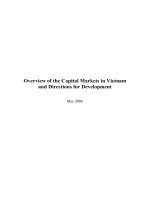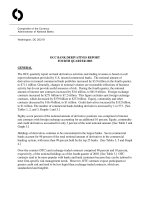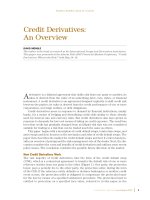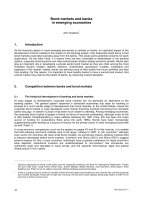David goldenberg derivatives markets routledge (2016)
Bạn đang xem bản rút gọn của tài liệu. Xem và tải ngay bản đầy đủ của tài liệu tại đây (6.67 MB, 705 trang )
DERIVATIVES MARKETS
Derivatives Markets is a thorough and well-presented textbook that offers
readers an introduction to derivatives instruments, with a gentle introduction
to mathematical finance, and provides a working knowledge of derivatives to
a wide spectrum of market participants.
This new and accessible book provides a lucid, down-to-earth, theoretically
rigorous but applied introduction to derivatives. Many insights have been
discovered since the seminal work in the 1970s and the text provides a bridge
to these insights, and incorporates them. It develops the skill sets needed to
both understand and intelligently use derivatives. These skill sets are developed,
in part, by using concept checks that test the reader’s understanding of the
material as it is presented.
The text discusses some fairly sophisticated topics not usually discussed in
introductory derivatives texts; for example, real-world electronic market
trading platforms such as CME’s Globex. On the theory side, there is a muchneeded and detailed discussion of what risk-neutral valuation really means in
the context of the dynamics of the hedge portfolio.
The text is a balanced, logical presentation of the major derivatives classes
including forward and futures contracts in Part 1, swaps in Part 2, and options
in Part 3. The material is unified by providing a modern conceptual framework
and exploiting the no-arbitrage relationships between the different derivatives
classes.
Some of the elements explained in detail in the text are:
•
•
•
•
•
•
•
Hedging, Basis Risk, Spreading, and Spread Basis Risk.
Financial Futures Contracts, their Underlying Instruments, Hedging and
Speculating.
OTC Markets and Swaps.
Option Strategies: Hedging and Speculating.
Risk-Neutral Valuation and the Binomial Option Pricing Model.
Equivalent Martingale Measures: A Modern Approach to Option Pricing.
Option Pricing in Continuous Time: From Bachelier to Black-Scholes
and Beyond.
Professor Goldenberg’s clear and concise explanations, running concept checks,
and end-of-chapter problems guide the reader through the derivatives markets,
developing the reader’s skill sets needed in order to incorporate and manage
derivatives in a corporate or risk management setting. This textbook is for
students, both undergraduate and postgraduate, as well as for those with an
interest in how and why these markets work and thrive.
David H. Goldenberg is an independent researcher in New York, USA.
DERIVATIVES
MARKETS
David H. Goldenberg
First published 2016
by Routledge
2 Park Square, Milton Park, Abingdon, Oxon OX14 4RN
by Routledge
711 Third Avenue, New York, NY 10017
Routledge is an imprint of the Taylor & Francis Group, an informa business
© 2016 David H. Goldenberg
The right of David H. Goldenberg to be identified as author of this
work has been asserted by him in accordance with the Copyright,
Designs and Patent Act 1988.
All rights reserved. No part of this book may be reprinted or
reproduced or utilised in any form or by any electronic, mechanical,
or other means, now known or hereafter invented, including
photocopying and recording, or in any information storage or retrieval
system, without permission in writing from the publishers.
Every effort has been made to contact copyright holders for their
permission to reprint material in this book. The publishers would be
grateful to hear from any copyright holder who is not here
acknowledged and will undertake to rectify any errors or omissions
in future editions of this book.
Trademark notice: Product or corporate names may be trademarks or
registered trademarks, and are used only for identification and
explanation without intent to infringe.
British Library Cataloguing in Publication Data
A catalogue record for this book is available from the British Library
Library of Congress Cataloging in Publication Data
Goldenberg, David Harold, 1949–
Derivatives markets / David H. Goldenberg.
1. Derivative securities. I. Title.
HG6024.A3G645 2015
332.64′57—dc23
2015000492
ISBN: 978-0-415-59901-6 (hbk)
ISBN: 978-1-315-68924–1 (ebk)
Typeset in Bembo and Univers
by Florence Production Ltd, Stoodleigh, Devon, UK
Additional materials are available on the companion website at
www.routledge.com/products/9780415599016
CONTENTS
List of figures
List of tables
Preface
Acknowledgments
PART 1
Forward Contracts and Futures Contracts
1. SPOT, FORWARD, AND FUTURES CONTRACTING
xxiii
xxvii
xxxi
xxxvii
1
3
2. HEDGING WITH FORWARD CONTRACTS
33
3. VALUATION OF FORWARD CONTRACTS ON ASSETS
WITHOUT A DIVIDEND YIELD
65
4. VALUATION OF FORWARD CONTRACTS ON ASSETS
WITH A DIVIDEND YIELD
87
5. FUTURES CONTRACTS: MARKET ORGANIZATION
121
6. HEDGING WITH FUTURES CONTRACTS, BASIS RISK,
AND SPREADING
139
7. INTRODUCTION TO FINANCIAL FUTURES
CONTRACTS
211
PART 2
Trading Structures Based on Forward
Contracts
8.
STRUCTURED PRODUCTS, INTEREST-RATE SWAPS
271
273
vi
CONTENTS
PART 3
Options
321
9. INTRODUCTION TO OPTIONS MARKETS
323
10. OPTION TRADING STRATEGIES, PART 1
345
11. RATIONAL OPTION PRICING
369
12. OPTION TRADING STRATEGIES, PART 2
415
13. MODEL-BASED OPTION PRICING IN DISCRETE TIME,
PART 1: THE BINOMIAL OPTION PRICING MODEL
(BOPM, N=1)
435
14. OPTION PRICING IN DISCRETE TIME,
PART 2: DYNAMIC HEDGING AND THE MULTI-PERIOD
BINOMIAL OPTION PRICING MODEL, N >1
473
15. EQUIVALENT MARTINGALE MEASURES: A MODERN
APPROACH TO OPTION PRICING
507
16. OPTION PRICING IN CONTINUOUS TIME
539
17. RISK-NEUTRAL VALUATION, EMMS, THE BOPM,
AND BLACK–SCHOLES
595
Index
637
DETAILED CONTENTS
List of figures
List of tables
Preface
Acknowledgments
xxiii
xxvii
xxxi
xxxvii
PART 1
Forward Contracts and Futures Contracts
CHAPTER 1
SPOT, FORWARD, AND FUTURES
CONTRACTING
1
3
1.1
Three Ways to Buy and Sell Commodities
5
1.2
Spot Market Contracting (Motivation and Examples)
5
1.3
Forward Market Contracting (Motivation and
Examples)
7
1.4
Problems with Forward Markets
11
1.5
Futures Contracts as a Solution to Forward Market
Problems (Motivation and Examples)
13
1.6
Futures Market Contracting
17
1.7
Mapping Out Spot, Forward, and Futures Prices
20
1.7.1
Present and Future Spot Prices
20
1.7.2
Forward Prices
24
1.7.3
Futures Prices
25
CHAPTER 2
HEDGING WITH FORWARD CONTRACTS
33
2.1
Motivation for Hedging
33
2.2
Payoff to a Long Forward Position
37
2.3
Payoff to a Short Forward Position
39
viii
DETAILED CONTENTS
2.4
Hedging with Forward Contracts
43
2.5
Profits to a Naked (Unhedged) Long Spot Position
45
2.6
Profits to a Fully Hedged Current Long Spot Position
47
2.7
Adding Profit Tables to Determine Profits from
a Fully Hedged Position
50
Combining Charts to See Profits from the
Hedged Position
54
2.8
CHAPTER 3
3.1
3.2
VALUATION OF FORWARD CONTRACTS
ON ASSETS WITHOUT A DIVIDEND
YIELD
65
Comparing the Payoffs from a Naked Long Spot
Position to the Payoffs from a Naked Long
Forward Position
66
Pricing Zero-Coupon, Unit Discount Bonds in
Continuous Time
69
3.2.1
3.2.2
Continuous Compounding and Continuous
Discounting
69
Pricing Zero-Coupon Bonds
71
3.3
Price vs. Value for Forward Contracts
73
3.4
Valuing a Forward Contract at Expiration
74
3.5
Valuing a Forward Contract at Initiation
75
3.6
Interpreting Forward Contracts via Synthetic
Forward Contracts
78
CHAPTER 4
VALUATION OF FORWARD CONTRACTS ON
ASSETS WITH A DIVIDEND YIELD
87
4.1
Stock Forwards when the Stock Pays Dividends
88
4.2
Modeling Continuous Yields: An Introduction to
Non-Stochastic Differential Equations
90
4.2.1
Modeling Zero-Coupon Bond Yields
90
4.2.2
Modeling Continuous Dividend Yields for
Stocks
93
DETAILED CONTENTS
ix
4.3
How Dividend Payments Affect Stock Prices
94
4.4
How Capital Gains Affect Stock Prices
98
4.5
Pricing Forward Contracts on Stocks with a Dividend
Yield Using the Net Interest Model
99
4.6
4.7
Pricing a Forward Contract on a Dividend-Paying
Stock Using No-Arbitrage
100
4.6.1
Arbitrage Definitions
100
4.6.2
Forward Pricing Using No-Arbitrage
102
Currency Spot and Currency Forwards
103
4.7.1
Price Quotes in the FX Market
103
4.7.2
Pricing Currency Forwards
105
4.7.3
Pricing FX Forward Contracts Using
No-Arbitrage
106
An Example of Pricing FX Forward Contracts
107
Appendix: Modeling Stock Returns with and without
Dividends
109
4.7.4
4.8
CHAPTER 5
FUTURES CONTRACTS: MARKET
ORGANIZATION
121
5.1
Futures Market Participants
122
5.2
Three Phases of Futures Trading
125
5.3
‘Buying’ and ‘Selling’ Futures Contracts
126
5.4
Alternative Types of Orders: Market, Market with
Protection, Limit
127
5.4.1
Market Orders and Market Orders with
Protection
127
5.4.2
Limit Orders
129
5.4.3
The Limit Order Book (LOB)
130
5.4.4
Depth in the LOB
131
5.5
Globex and the Globex LOB
134
5.6
Pit Trading and the Order Flow Process
136
x
5.7
DETAILED CONTENTS
Operations and Functions of the Clearing House
5.7.1
5.7.2
5.7.3
5.7.4
5.8
5.9
6.2
The Clearing Process and Offsetting Futures
Trades
141
Marking to Market and the Daily Settlement
Process
144
Tracking the Equity in an Investor’s Account
151
5.8.1
155
Offset vs. Delivery
Cash Settlement vs. Commodity Settlement
HEDGING WITH FUTURES CONTRACTS,
BASIS RISK, AND SPREADING
157
163
Hedging as Portfolio Theory
165
6.1.1
Hedging as Synthesizing Negative Correlation
165
6.1.2
Hedging’s Objective
167
6.1.3
Hedging Definitions
168
Traditional Theories of Hedging
6.2.2
6.2.3
6.2.4
6.4
139
153
6.2.1
6.3
Matching Trades and Guaranteeing Futures
Obligations
The Effective Price and the Invoice Price upon
Delivery
CHAPTER 6
6.1
139
168
Traditional (One-for-One) Theory with
No Basis Risk
168
Profits in a Traditional Short Hedge and
the Basis
171
When is a Traditional (One-for-One) Hedge
with No Basis Risk Consistent with
No-Arbitrage?
172
Traditional (One-for-One) Theory with
Basis Risk
174
Basis Risk vs. Spot Price Risk
178
6.3.1
179
When Does Traditional Hedging Reduce Risk?
Non-Traditional (-for-One) Hedging Theory
182
DETAILED CONTENTS
6.5
6.6
xi
6.4.1
When Does -for-One Hedging Reduce Risk?
183
6.4.2
Minimum Variance Hedging
185
Carrying Charge Hedging
188
6.5.1
Implications of Convergence
189
6.5.2
Overall Profits in a Carrying Charge Hedge
189
6.5.3
Equilibrium (No-Arbitrage) in a Full Carrying
Charge Market
190
Comparing Equilibrium Forward Pricing and
Equilibrium Futures Pricing
193
6.7
Storage and the Price (Cost) of Storage
195
6.8
Contango and Backwardation
198
6.9
Spreads as a Speculative Investment
199
CHAPTER 7
7.1
7.2
211
Currency Futures
213
7.1.1
Contract Specifications
213
7.1.2
The Quote Mechanism: Futures Price
Quotes
216
Risk Management Strategies Using Currency
Futures
217
7.2.1
Exchange Rate Risks and Currency Futures
Positions
217
7.2.2
The Rolling Hedge Strategy
220
7.2.3
Interpretations of Profits from the Rolling
Hedge
221
Numerical Example of the Roll-Over Hedge
Strategy
223
7.2.4
7.3
INTRODUCTION TO FINANCIAL FUTURES
CONTRACTS
Hedging
224
7.3.1
Issues in Hedging, Quantity Uncertainty
224
7.3.2
Currency Futures Pricing vs. Currency Forward
Pricing
225
xii
7.4
DETAILED CONTENTS
Stock Index Futures
225
7.4.1
The S&P 500 Spot Index
225
7.4.2
S&P 500 Stock Index Futures Contract
Specifications
227
The Quote Mechanism for S&P 500 Futures
Price Quotes
230
7.4.3
7.5
Risk Management Using Stock Index Futures
231
7.5.1
Pricing and Hedging Preliminaries
231
7.5.2
Monetizing the S&P 500 Spot Index
231
7.5.3
Profits from the Traditional Hedge
235
7.5.4
Risk, Return Analysis of the Traditional
Hedge
236
7.5.5
Risk-Minimizing Hedging
238
7.5.6
Adjusting the Naive Hedge Ratio to Obtain
the Risk-Minimizing Hedge Ratio
239
Risk Minimizing the Hedge Using Forward
vs. Futures Contracts
241
Cross-Hedging, Adjusting the Hedge for
non S&P 500 Portfolios
243
7.5.7
7.5.8
7.6
7.7
The Spot Eurodollar Market
245
7.6.1
Spot 3-month Eurodollar Time Deposits
246
7.6.2
Spot Eurodollar Market Trading
Terminology
248
7.6.3
LIBOR3, LIBID3, and Fed Funds
250
7.6.4
How Eurodollar Time Deposits are Created
252
Eurodollar Futures
254
7.7.1
Contract Specifications
254
7.7.2
The Quote Mechanism, Eurodollar Futures
256
7.7.3
Forced Convergence and Cash Settlement
258
7.7.4
How Profits and Losses are Calculated on
Open ED Futures Positions
262
DETAILED CONTENTS
PART 2
Trading Structures Based on Forward
Contracts
CHAPTER 8
8.1
Swaps as Strips of Forward Contracts
8.1.1
274
Strips of Forward Contracts
277
Basic Terminology for Interest-Rate Swaps:
Paying Fixed and Receiving Floating
278
8.2.2
8.2.3
8.4
273
275
8.2.1
8.3
271
Commodity Forward Contracts as Single
Period Swaps
8.1.2
8.2
STRUCTURED PRODUCTS, INTEREST-RATE
SWAPS
xiii
Paying Fixed in an IRD (Making Fixed
Payments)
278
Receiving Variable in an IRD (Receiving
Floating Payments)
279
Eurodollar Futures Strips
280
Non-Dealer Intermediated Plain Vanilla Interest-Rate
Swaps
281
Dealer Intermediated Plain Vanilla Interest-Rate
Swaps
284
8.4.1
An Example
284
8.4.2
Plain Vanilla Interest-Rate Swaps as Hedge
Vehicles
286
Arbitraging the Swaps Market
292
8.4.3
8.5
Swaps: More Terminology and Examples
293
8.6
The Dealer’s Problem: Finding the Other Side to
the Swap
294
8.7
Are Swaps a Zero Sum Game?
298
8.8
Why Financial Institutions Use Swaps
299
8.9
Swaps Pricing
301
8.9.1
301
An Example
xiv
DETAILED CONTENTS
8.9.2
Valuation of the Fixed-Rate Bond
303
8.9.3
Valuation of the Floating-Rate Bond
305
8.9.4
Valuation of the Swap at Initiation
308
8.9.5
Implied Forward Rates (IFRs)
309
8.9.6
Three Interpretations of the Par Swap Rate
311
PART 3
Options
CHAPTER 9
321
INTRODUCTION TO OPTIONS MARKETS
323
9.1
Options and Option Scenarios
323
9.2
A Framework for Learning Options
326
9.3
Definitions and Terminology for Plain Vanilla
Put and Call Options
327
9.4
A Basic American Call (Put) Option Pricing Model
332
9.5
Reading Option Price Quotes
334
9.6
Going Beyond the Basic Definitions: Infrastructure
to Understand Puts and Calls
337
Identifying Long and Short Positions in an
Underlying
339
9.7
CHAPTER 10
OPTION TRADING STRATEGIES,
PART 1
345
10.1 Profit Diagrams
346
10.2 Eight Basic (Naked) Strategies Using the Underlying,
European Puts and Calls, and Riskless, Zero-Coupon
Bonds
347
10.2.1 Strategy 1. Long the Underlying
347
10.2.2 Strategy 2. Short the Underlying
349
10.2.3 Strategy 3. Long a European Call Option
on the Underlying
351
DETAILED CONTENTS
xv
10.2.4 Strategy 4. Short a European Call Option
on the Underlying
355
10.2.5 Strategy 5. Long a European Put Option
on the Underlying
357
10.2.6 Strategy 6. Short a European Put Option
on the Underlying
359
10.2.7 Strategy 7. Long a Zero-Coupon Riskless
Bond and Hold it to Maturity
360
10.2.8 Strategy 8. Short a Zero-Coupon Riskless
Bond and Hold it to Maturity
362
CHAPTER 11
RATIONAL OPTION PRICING
369
11.1 Model-Independent vs. Model-Based Option Pricing
370
11.2 Relative Pricing Trades vs. Directional Trades
371
11.3 The Dominance Principle
373
11.4 Implications of the Dominance Principle, ROP for
Puts and Calls
374
11.4.1 Lower Bound for an American Call Option on
an Underlying with no Dividends (LBAC)
374
11.4.2 Lower Bound for a European Call Option on
an Underlying with no Dividends (LBEC)
375
11.4.3 Lower Bound for an American Put Option on
an Underlying with no Dividends (LBAP)
378
11.4.4 Lower Bound for a European Put Option on
an Underlying with no Dividends (LBEP)
380
11.4.5 Lower Bound for a European Call Option on
an Underlying with Continuous Dividends
(LBECD)
382
11.4.6 Lower Bound for an American Call Option on
an Underlying with Continuous Dividends
(LBACD)
383
11.4.7 Lower Bound for a European Put Option on
an Underlying with Continuous Dividends
(LBEPD)
386
xvi
DETAILED CONTENTS
11.4.8 Lower Bound for an American Put Option on
an Underlying with Continuous Dividends
(LBAPD)
11.5 Static Replication and European Put-Call Parity
(No Dividends)
387
388
11.5.1 Partially Replicating a European Call Option
(the Embedded Forward Contract)
388
11.5.2 Fully Replicating a European Call Option
(the Embedded Insurance Contract)
391
11.5.3 From Strategies to Current Costs and Back
393
11.5.4 Working Backwards from Payoffs to Costs
to Derive European Put-Call Parity
393
11.6 Basic Implications of European Put-Call Parity
394
11.6.1 What is a European Call Option?
394
11.6.2 The Analogue of the Basic American
Option Pricing Model for European Options
396
11.6.3 What is a European Put Option?
398
11.7 Further Implications of European Put-Call Parity
11.7.1 Synthesizing Forward Contract from
Puts and Calls
399
399
11.8 Financial Innovation using European Put-Call
Parity
401
11.8.1 Generalized Forward Contracts
401
11.8.2 American Put-Call Parity (No Dividends)
403
11.9 Postscript on ROP
CHAPTER 12
OPTION TRADING STRATEGIES,
PART 2
405
415
12.1 Generating Synthetic Option Strategies from
European Put-Call Parity
416
12.2 The Covered Call Hedging Strategy
419
12.2.1 Three Types Of Covered Call Writes
420
DETAILED CONTENTS
xvii
12.2.2 Economic Interpretation of the Covered
Call Strategy
12.3 The Protective Put Hedging Strategy
426
427
12.3.1 Puts as Insurance
427
12.3.2 Economic Interpretation of the Protective
Put Strategy
429
CHAPTER 13
MODEL-BASED OPTION PRICING IN
DISCRETE TIME, PART 1: THE BINOMIAL
OPTION PRICING MODEL (BOPM, N=1)
435
13.1 The Objective of Model-Based Option Pricing
(MBOP)
437
13.2 The Binomial Option Pricing Model, Basics
437
13.2.1 Modeling Time in a Discrete Time Framework
437
13.2.2 Modeling the Underlying Stock Price
Uncertainty
438
13.3 The Binomial Option Pricing Model, Advanced
440
13.3.1 Path Structure of the Binomial Process,
Total Number of Price Paths
440
13.3.2 Path Structure of the Binomial Process,
Total Number of Price Paths Ending at a
Specific Terminal Price
442
13.3.3 Summary of Stock Price Evolution for the
N-Period Binomial Process
444
13.4 Option Valuation for the BOPM (N=1)
445
13.4.1 Step 1, Pricing the Option at Expiration
445
13.4.2 Step 2, Pricing the Option Currently
(time t=0)
446
13.5 Modern Tools for Pricing Options
448
13.5.1 Tool 1, The Principle of No-Arbitrage
448
13.5.2 Tool 2, Complete Markets or Replicability,
and a Rule of Thumb
449
13.5.3 Tool 3, Dynamic and Static Replication
450
xviii
DETAILED CONTENTS
13.5.4 Relationships between the Three Tools
13.6 Synthesizing a European Call Option
450
453
13.6.1 Step 1, Parameterization
454
13.6.2 Step 2, Defining the Hedge Ratio and the
Dollar Bond Position
455
13.6.3 Step 3, Constructing the Replicating
Portfolio
456
13.6.4 Step 4, Implications of Replication
462
13.7 Alternative Option Pricing Techniques
464
13.8 Appendix: Derivation of the BOPM (N=1) as a
Risk-Neutral Valuation Relationship
467
CHAPTER 14
OPTION PRICING IN DISCRETE TIME,
PART 2: DYNAMIC HEDGING AND THE
MULTI-PERIOD BINOMIAL OPTION PRICING
MODEL, N>1
14.1 Modeling Time and Uncertainty in the BOPM,
N>1
473
475
14.1.1 Stock Price Behavior, N=2
475
14.1.2 Option Price Behavior, N=2
476
14.2 Hedging a European Call Option, N=2
477
14.2.1 Step 1, Parameterization
477
14.2.2 Step 2, Defining the Hedge Ratio and the
Dollar Bond Position
478
14.2.3 Step 3, Constructing the Replicating
Portfolio
478
14.2.4 The Complete Hedging Program for the
BOPM, N=2
484
14.3 Implementation of the BOPM for N=2
485
14.4 The BOPM, N>1 as a RNVR Formula
490
14.5 Multi-period BOPM, N>1: A Path Integral
Approach
493
DETAILED CONTENTS
xix
14.5.1 Thinking of the BOPM in Terms of Paths
493
14.5.2 Proof of the BOPM Model for general N
499
CHAPTER 15
EQUIVALENT MARTINGALE MEASURES:
A MODERN APPROACH TO OPTION PRICING
15.1 Primitive Arrow–Debreu Securities and Option
Pricing
507
508
15.1.1 Exercise 1, Pricing B(0,1)
510
15.1.2 Exercise 2, Pricing ADu() and ADd()
511
15.2 Contingent Claim Pricing
514
15.2.1 Pricing a European Call Option
514
15.2.2 Pricing any Contingent Claim
515
15.3 Equivalent Martingale Measures (EMMs)
517
15.3.1 Introduction and Examples
517
15.3.2 Definition of a Discrete-Time Martingale
521
15.4 Martingales and Stock Prices
15.4.1 The Equivalent Martingale Representation
of Stock Prices
15.5 The Equivalent Martingale Representation of
Option Prices
521
524
526
15.5.1 Discounted Option Prices
527
15.5.2 Summary of the EMM Approach
528
15.6 The Efficient Market Hypothesis (EMH), A Guide
To Modeling Prices
529
15.7 Appendix: Essential Martingale Properties
533
CHAPTER 16
OPTION PRICING IN CONTINUOUS TIME
539
16.1 Arithmetic Brownian Motion (ABM)
540
16.2 Shifted Arithmetic Brownian Motion
541
16.3 Pricing European Options under Shifted Arithmetic
Brownian Motion with No Drift (Bachelier)
542
xx
DETAILED CONTENTS
16.3.1 Theory (FTAP1 and FTAP2)
542
16.3.2 Transition Density Functions
543
16.3.3 Deriving the Bachelier Option Pricing
Formula
547
16.4 Defining and Pricing a Standard Numeraire
551
16.5 Geometric Brownian Motion (GBM)
553
16.5.1 GBM (Discrete Version)
553
16.5.2 Geometric Brownian Motion (GBM),
Continuous Version
559
16.6 Itô’s Lemma
562
16.7 Black–Scholes Option Pricing
566
16.7.1 Reducing GBM to an ABM with Drift
567
16.7.2 Preliminaries on Generating Unknown
Risk-Neutral Transition Density Functions
from Known Ones
570
16.7.3 Black–Scholes Options Pricing from Bachelier
571
16.7.4 Volatility Estimation in the Black–Scholes
Model
582
16.8 Non-Constant Volatility Models
585
16.8.1 Empirical Features of Volatility
585
16.8.2 Economic Reasons for why Volatility is not
Constant, the Leverage Effect
586
16.8.3 Modeling Changing Volatility, the Deterministic
Volatility Model
586
16.8.4 Modeling Changing Volatility, Stochastic
Volatility Models
16.9 Why Black–Scholes is Still Important
CHAPTER 17
RISK-NEUTRAL VALUATION, EMMS,
THE BOPM, AND BLACK–SCHOLES
17.1 Introduction
17.1.1 Preliminaries on FTAP1 and FTAP2 and
Navigating the Terminology
587
588
595
596
596
DETAILED CONTENTS
xxi
17.1.2 Pricing by Arbitrage and the FTAP2
597
17.1.3 Risk-Neutral Valuation without Consensus
and with Consensus
598
17.1.4 Risk-Neutral Valuation without Consensus,
Pricing Contingent Claims with Unhedgeable
Risks
599
17.1.5 Black–Scholes’ Contribution
601
17.2 Formal Risk-Neutral Valuation without Replication
601
17.2.1 Constructing EMMs
601
17.2.2 Interpreting Formal Risk-Neutral Probabilities
602
17.3 MPRs and EMMs, Another Version of FTAP2
605
17.4 Complete Risk-Expected Return Analysis of the
Riskless Hedge in the (BOPM, N=1)
607
17.4.1 Volatility of the Hedge Portfolio
608
17.4.2 Direct Calculation of S
611
17.4.3 Direct Calculation of C
612
17.4.4 Expected Return of the Hedge Portfolio
616
17.5 Analysis of the Relative Risks of the Hedge Portfolio’s
Return
618
17.5.1 An Initial Look at Risk Neutrality in the Hedge
Portfolio
618
17.5.2 Role of the Risk Premia for a Risk-Averse
Investor in the Hedge Portfolio
620
17.6 Option Valuation
Index
624
17.6.1 Some Manipulations
624
17.6.2 Option Valuation Done Directly by a
Risk-Averse Investor
626
17.6.3 Option Valuation for the Risk-Neutral Investor
631
637
This page intentionally left blank
FIGURES
1.1
1.2
1.3
1.4
2.1
2.2
2.3
2.4
3.1
3.2
3.3
3.4
5.1
5.2
5.3
5.4
6.1
6.2
6.3
6.4
7.1
7.2
7.3
7.4
7.5
7.6
7.7
7.8
7.9
Canada/US Foreign Exchange Rate
Intermediation by the Clearing House
Offsetting Trades
Gold Fixing Price in London Bullion Market (USD$)
Graphical Method to Get Hedged Position Profits
Payoff Per Share to a Long Forward Contract
Payoff Per Share to a Short Forward Contract
Profits per bu. for the Unhedged Position
Profits Per Share to a Naked Long Spot Position
Payoffs Per Share to a Naked Long Spot Position
Payoffs (=Profits) Per Share to a Naked Long Forward
Position
Payoffs Per Share to a Naked Long Spot Position and to a
Naked Long Forward Position
Order Flow Process (Pit Trading)
The Futures Clearing House
Offsetting Trades
Overall Profits for Example 2
Long vs. Short Positions
Synthetic Treasury Bill vs. Actual
Perfectly Negatively Correlated Asset Returns
Synthesizing a Treasury Bill
The Rolling Hedge Bases (4 Periods)
The Rolling Hedge Bases (3 Periods)
Hedging a Cross Hedge
Currency Composition of Foreign Exchange Reserves
(Pie Chart)
Currency Composition of Foreign Exchange Reserves
(Graph)
LIBOR3 vs. Fed Funds
Eurodollar Deposit Creation
Timing in Eurodollar Futures
Forced Convergence of ED Futures
4
15
15
22
55
62
62
63
67
67
68
68
137
142
143
150
164
165
166
166
221
223
244
247
248
251
253
257
260
xxiv
FIGURES
8.1
Paying Fixed, Receiving Floating in a Commodity
8.2
Forward Contract
Long’s Position in a Strip of Forward Contracts
276
277
8.3
8.4
8.5
Cash Flows to the Short in an ED Futures Strip
Cash Flows in a Non-Intermediated Swap
Cash Flows to Alfa in the Non-Intermediated Swap
281
282
284
8.6
8.7
The Bid Side in a Dealer-Intermediated Swap with BBB
The Asked Side in a Dealer-Intermediated Swap with BBB
285
286
8.8
8.9
8.10
Synthetic Fixed-Rate Strategy for BBB
Bid Side in a Dealer-Intermediated Swap with AA
Asked Side in a Dealer-Intermediated Swap with AA
290
295
295
8.11
8.12
Synthetic Floating-Rate Financing for AA
Full Set of Swap Cash Flows for BBB, AA, and the Dealer
297
298
8.13
Cash Flows for an Annual Rate Swap from the Dealer’s
Point of View
Decomposing a Swap’s Cash Flows into its Implicit Bonds
302
303
The Implicit Fixed-Rate Bond in a Swap, Written in Terms of
Zero-Coupon Bonds
304
8.16
8.17
8.18
The Floating-Rate Bond Implicit in the Swap
Floating-Rate Payments as Expected Cash Flows
Valuing the Floating-Rate Bond One Period Prior to Maturity
306
306
306
8.19
8.20
Valuing the Floating-Rate Bond Two Periods Prior to Maturity
Complete Valuation of the Implicit Floating-Rate Bond in an
307
8.21
8.22
Interest-Rate Swap
The Two Strategies that Generate Implied Forward Rates
The First Interpretation of the Par Swap Rate in Terms of
308
309
9.1
Implied Forward Rates
Moneyness of a Call (Put) Option
311
329
9.2
9.3
9.4
The Options Clearing House (Calls)
The Options Clearing House (Puts)
Long vs. Short Positions
331
332
340
9.5
9.6
CBOE Equity Option Specifications
CBOE Mini Equity Option Specifications
343
344
10.1
10.2
10.3
Merck Stock Price (11/30/2007 through 2/29/2008)
Strategy 1: Profits from a Long Position in an Underlying
Strategy 2: Profits from a Short Position in an Underlying
346
348
350
10.4
Strategy 3: Profits from a Long Position in a European Call
Option on an Underlying
352
8.14
8.15









